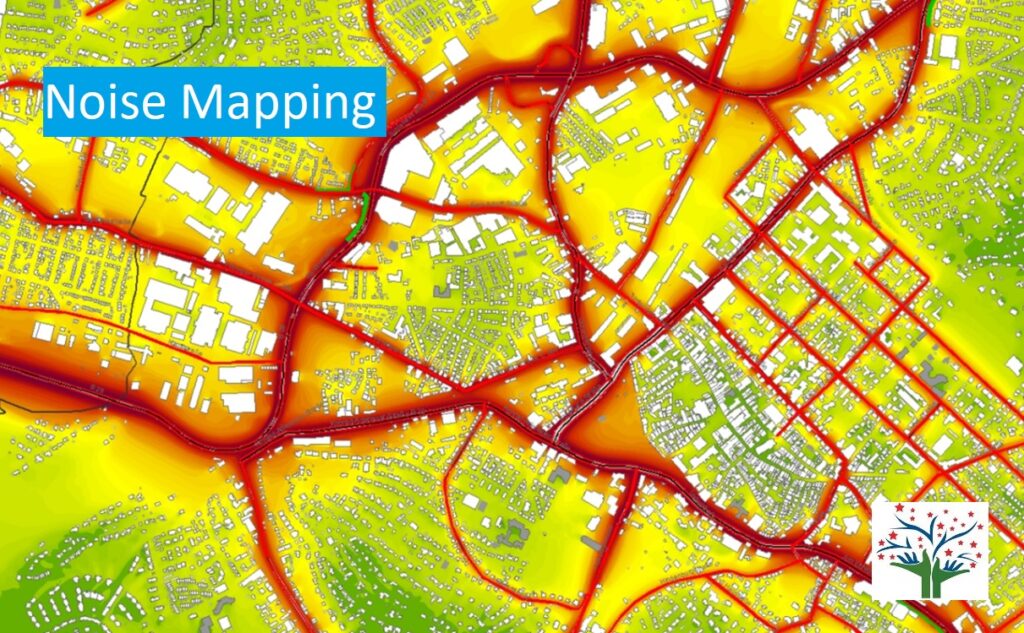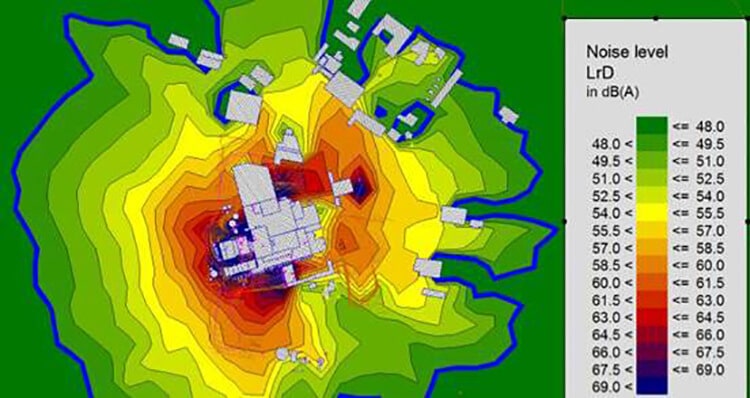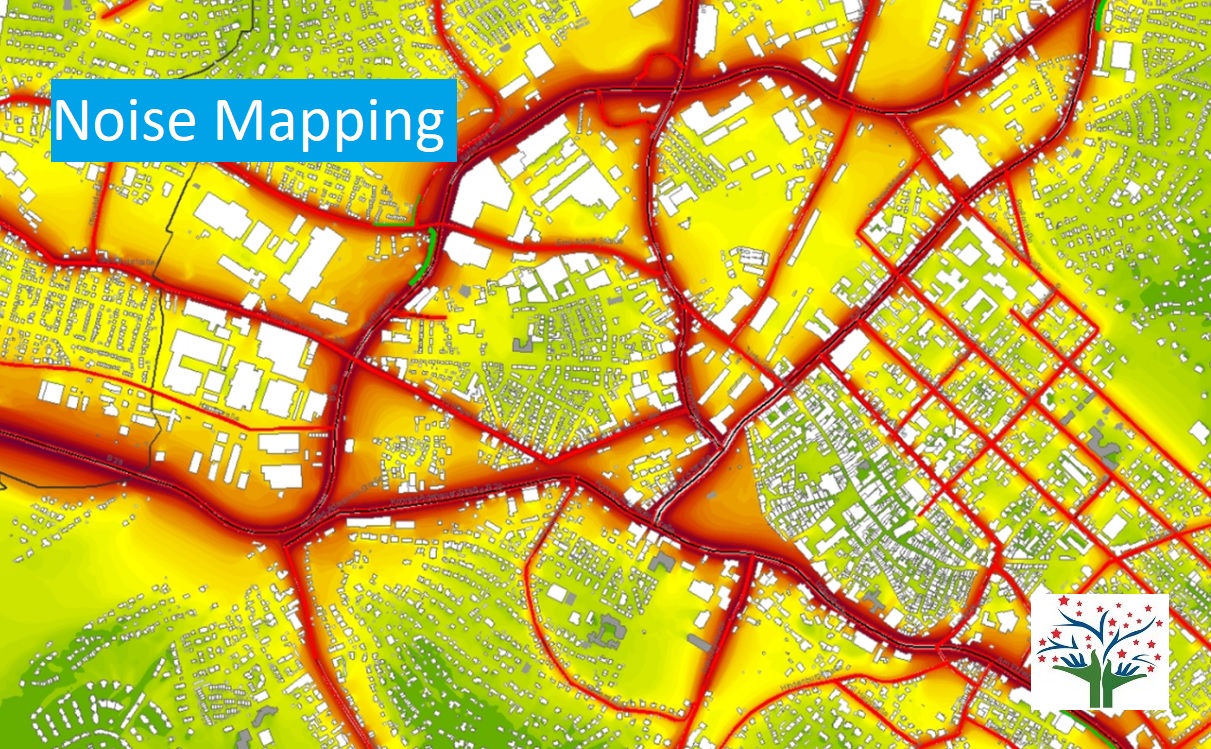Noise Mapping
A noise mapping study is a detailed analysis of the noise levels in a specific area. It involves the use of sound sensors, computer modeling or software and data analysis to create a detailed illustration of noise levels in the area of study.
Noise contour mapping are simply colored map to indicate intensity of noise on the map of place of study conducted. It is very helpful to identify area where noise levels exceed recommended threshold.

What is meant by Noise Mapping?
Let’s understand it in detail. Noise mapping is method of collecting noise level data using noise monitoring sensors, data modelling and visualizing in graphical manner. The purpose of this process is to get detailed map of noise levels that can highlight areas where noise levels are exceeded so that measures can be taken to reduce noise.
Types of Noise Mapping
There are many types of Noise Mapping but most popular types are
- Strategic Noise Mapping: This type is used by government agencies and large corporates to measure noise reduction measures they have taken for big projects
- Environmental Noise Mapping: Environmental noise mapping is done by environmental Protection agencies to measure impact of noise on environment and wildlife.
- Community Noise mapping: In this type local communities are taken into consideration where noise pollution is at very high and to develop strategies reduce noise levels.
Noise Mapping Procedure
Noise Mapping Procedures can be divided in three types based on tools used i.e., Sound Sensors, Computer Simulation and Data Analysis.
Also read about Noise Level Monitoring Procedure
In Noise mapping procedure, Sound Sensors play very important role. Noise level monitoring Sensors are placed in strategic locations in the study area. Data is collected periodically from noise sensors and it is used to create detailed noise map which shows distribution of noise levels in study area.
Computer Modelling or Noise mapping software is another tool used in Noise Mapping procedure. In this method map is fed to the software and based on conditions it can generate and simulate noise patterns based on conditions. For e.g., if we create road or construction project in nearby area then noise level can increase for that area and then based on noise reduction techniques it can also shows which technique is impactful in those conditions.
Data Analysis is also a great tool for Noise Mapping. This Noise Mapping procedure involves analyzing large amount of data on noise level. And then after studying trends and patterns, high noise level areas and potential sources can be identified. This can help to take measures to reduce Noise levels and prioritize areas for action.
Learn more about Noise Level Monitoring and Testing
Noise Mapping Software
There are many noise mapping software are available in the market. Here are some of the popular ones:
- CadnaA: This is the popular among all. This has features to add virtual model of area and simulate noises in different conditions. This is widely preferred by researchers, government agencies etc.
- SoundPLAN: It allows to create detailed map and perform various analysis. This is popular in environmental consultants and government agencies
- IMMI: This is noise modelling software which can simulate noise level at airports, traffic and inplant noises, etc.
- NoiSee: This is good tool to create detailed noise map using data gathered from Noise sensors and computer models
- Norsonic Nor-Map: This has options for indoor and outdoor noise map.
- Odeon: This also has features like indoor and outdoor noise mapping. It can simulate noise mapping for complex terrain.
- AERMOD: A software can be used for air quality and noise quality modelling.
- INM: This is used by aviation authorities for airport noise mapping
- SOUNDRISK: A software can be used for environmental noise mapping for noise generated from transportation, industries and wind turbines, etc.
- SIMUL8 Noise: This is used to simulate noise mapping from sources like industrial facilities, construction sites and transportation, etc.

Traffic Noise Monitoring
Traffic noise monitoring is an essential aspect of urban planning and environmental management, aimed at understanding and mitigating the impact of road traffic on communities. It involves the systematic and continuous measurement of noise levels generated by vehicles on roads, highways, and other transportation routes.
By deploying specialized noise monitoring equipment and sensors strategically throughout urban areas, authorities can gather real-time data on traffic noise patterns and assess its effects on public health and overall quality of life.
Through traffic noise monitoring, city planners and policymakers gain valuable insights into noise pollution hotspots and peak hours of noise generation, enabling them to develop targeted interventions.
This data-driven approach empowers decision-makers to implement effective measures such as traffic management strategies, sound barriers, and urban design improvements to reduce noise levels and create more livable environments for residents.
Additionally, traffic noise monitoring plays a crucial role in adhering to regulatory standards and guidelines set by environmental agencies. By tracking noise emissions and comparing them against permissible limits, local governments can ensure compliance and take timely actions to address any potential violations.
Ultimately, the process of traffic noise monitoring fosters sustainable and people-centric urban planning, contributing to healthier and more harmonious communities where residents can enjoy the benefits of reduced noise pollution and improved overall well-being.
Benefits of Noise Mapping
The main benefit of Noise mapping is managing environmental Noise Pollution. This Procedure provides details understanding of noise levels in study area. It also helps in identifying sources of noise pollution and impacting area which helps in taking effective measure to reduce noise levels.
It can also help to take measures to reduce noise for environment and communities. Noise Map helps to identify areas where sound barriers can reduce noise levels and restriction on noisy activities in certain areas.
in a conclusion, Noise Mapping is helping to take significant step towards creating a healthier and more sustainable environment.
A noise map serves as a valuable tool for understanding and managing noise pollution within a specific geographic area. By visually representing noise levels across neighborhoods, streets, and public spaces, noise maps help urban planners, policymakers, and environmental authorities make informed decisions. These maps assist in identifying noise hotspots, areas of concern, and noise-sensitive zones, facilitating the design of effective noise mitigation strategies.
Additionally, noise maps raise public awareness about the extent of noise pollution, encouraging community engagement and advocacy for quieter and healthier living environments. Overall, noise maps play a crucial role in shaping urban development, ensuring regulatory compliance, and fostering public participation in efforts to reduce noise pollution’s impact on quality of life.
Creating a noise map involves a systematic approach that integrates real-world noise measurements with geographic information system (GIS) technology. Initial data collection is conducted using sound level meters positioned across the target area to capture noise levels from various sources and at different times.
This collected data is then processed and analyzed to determine average noise levels and trends. Using GIS software, the noise measurements are mapped onto a digital representation of the area, often using contour lines or color gradients to visually depict noise levels. Interpolation techniques and noise propagation models may be applied to estimate noise levels between measurement points and account for factors like distance and barriers.
The resulting noise map provides a clear spatial overview of noise distribution, aiding urban planning, environmental assessment, and the implementation of noise abatement strategies. Regular updates and validation against real measurements help maintain the accuracy and relevance of the noise map over time.
Noise contour mapping is created through a series of steps involving data collection, analysis, and visualization. First, noise measurements are taken at multiple points within the study area using sound level meters. The collected data is then processed to calculate average noise levels and identify patterns.
Using Geographic Information System (GIS) software, noise measurements are spatially plotted, and contour lines are drawn to connect points with similar noise levels. Interpolation techniques and noise propagation models can be applied to estimate noise levels between measurement points, resulting in a contour map that visually represents the distribution of noise intensity across the area.

